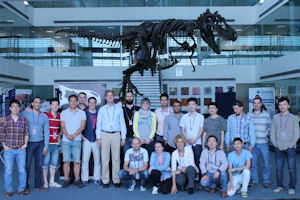Professor Peter Lee appointed Acting Director of RCaH
11 Apr 2016
Professor Peter Lee, from the School of Materials, has been appointed Acting Director of the Research Complex at Harwell (RCaH), an MRC-run joint venture between five of the UK Research Councils and Diamond Light Source, the UK’s Synchrotron.

The RCaH, founded with a £25m capital grant, opened in 2010 with a focus on multidisciplinary research benefiting from access to cutting-edge technology at the large-scale national facilities on the Harwell site. These include Diamond, the ISIS neutron & muon source and the Central Laser Facility.
The Complex is also close to other leading facilities such as the MRC Mary Lyon Centre for mouse functional genomics and the MRC Mammalian Genetics Unit. It offers the opportunity to engage with emerging developments on the Harwell Campus including the electron microscopy Bio-Imaging Centre (eBIC), the UK XFEL Hub and completion of the Phase III expansion at Diamond, which will result in a total of 32 state-of-the-art beamlines.
Almost 200 Manchester Academics and Researchers have visited the RCaH, benefiting from interactions ranging from hosting of PDRAs and students to provision of equipment, workshops and training courses, mostly focused on synchrotron and neutron techniques. This has included residential courses for almost 20 Centres for Doctoral Training including Regenerative Medicine (FLS), Materials for Demanding Environments (MACE) and Advanced Metallic Systems (SOM).
The RCaH currently houses around 30 Manchester researchers, supporting a grant portfolio of ~ £16M held with Investigators from FLS, MHS, SOM, SEAES, MACE and Dentistry. Topics range from correlative X-ray imaging of structural evolution in materials, fracking and volcanology, to biomaterials and joint mechanics.
Peter says, ”It’s an honour to be appointed Acting Director of this exciting facility, encouraging interactions between scientists from very different backgrounds to bridge the interface between disciplines using techniques at the UK’s synchrotron and neutron sources. I’m looking forward to growing activities at the Research Complex and to forging links to the outstanding activities at Manchester, such as the Sir Henry Royce Institute.”
In addition to Prof. Lee’s group, there are several early career academics resident in the RCaH. One of these is Dr Gowishan Poologasundarampillai who is developing Manchester’s biomaterials activities at Harwell, with a particular focus on Organic/Inorganic Hybrid “Bioinks” for 3D Bioprinting.
Professor Lee has a group of around 20 researchers based at Harwell developing environmental cells and microstructural simulations of material behaviour in operando. His group will also be presenting their research “Science in 4D” at the Royal Society Summer Science Exhibition, July 5th -10th. The group are pictured above.
